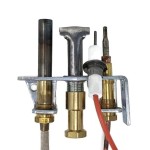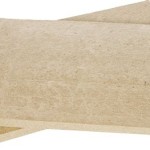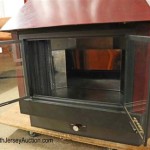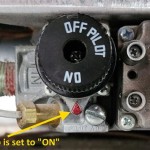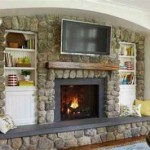Elevating Your Hearth: Exploring Wood Trim Around Brick Fireplaces
A brick fireplace stands as a focal point in many homes, radiating warmth and character. While brick possesses inherent aesthetic appeal, the addition of wood trim can significantly enhance its visual impact, creating a more refined and integrated design. Wood trim offers a multitude of possibilities, from classic and traditional to modern and minimalist, allowing homeowners to tailor the fireplace surround to their specific tastes and the overall style of their living space. This article explores the various considerations involved in incorporating wood trim around a brick fireplace, including design options, wood selection, installation techniques, and maintenance practices.
Design Considerations for Wood Trim Around Brick Fireplaces
The design phase is crucial in ensuring that the wood trim complements the brick fireplace and contributes to the desired aesthetic. Several factors warrant careful consideration before commencing the project. The existing style of the home is paramount; the trim should harmonize with the architectural details and interior décor. In a traditional setting, intricate moldings and rich wood tones may be appropriate, while a modern home might benefit from clean lines and lighter, more neutral finishes. The color and texture of the brick itself also influence the trim selection. Darker brick may pair well with lighter woods to create contrast, whereas lighter brick might allow for darker, richer wood tones. Finally, the proportions of the fireplace and the surrounding room should guide the size and scale of the trim.
One fundamental decision is the type of trim to be used. Simple, flat trim offers a clean and understated look, ideal for contemporary spaces. More elaborate options include crown molding, chair rail, and decorative panels. A mantel shelf can be incorporated to provide a functional surface for displaying decorative items. The mantel's design should be consistent with the overall trim style. The dimensions of the trim are also important. A trim that is too small may appear insignificant, while trim that is too large can overwhelm the fireplace and the room. It is essential to measure the fireplace accurately and consider the surrounding wall space to determine the appropriate trim dimensions.
Fireplace surrounds often benefit from considering the overall spatial context. Think about how the wood trim will integrate with the surrounding walls, flooring, and furniture. The placement of the trim can also influence the perceived size and shape of the fireplace. For instance, a wide trim can make a narrow fireplace appear wider, while a vertical trim can accentuate the height of the fireplace. The use of color and finish is another key consideration. The wood trim can be painted to match the walls, stained to highlight the natural wood grain, or finished with a combination of paint and stain. The chosen finish should complement the brick and the overall color scheme of the room.
Selecting the Right Wood for Fireplace Trim
The selection of wood species significantly impacts the appearance, durability, and cost of the fireplace trim. A variety of wood options are available, each with its own unique characteristics. Hardwoods, such as oak, maple, and cherry, are known for their strength, durability, and attractive grain patterns. Softwoods, such as pine and fir, are more affordable and easier to work with, but they are generally less resistant to wear and tear. The choice of wood will depend on the desired aesthetic, the budget, and the level of maintenance required.
Oak is a popular choice for fireplace trim due to its durability, readily available nature, and distinctive grain pattern. Red oak offers a warm, reddish-brown hue, while white oak has a more neutral, beige tone. Maple is another durable hardwood with a finer, more uniform grain than oak. It is often chosen for its smooth surface and ability to accept paint and stain evenly. Cherry is prized for its rich, reddish-brown color and elegant grain pattern. It is a more expensive option than oak or maple, but its beauty and durability make it a worthwhile investment for high-end installations.
Pine is a cost-effective softwood option that is easy to work with and readily available. It is often used for painted trim, as its grain pattern is less pronounced than hardwoods. Fir is another softwood that is often used for trim and molding. It has a straight grain and a reddish-brown color. Both pine and fir are susceptible to scratches and dents, so they may not be the best choice for high-traffic areas. In addition to solid wood, engineered wood products, such as medium-density fiberboard (MDF), are also sometimes used for fireplace trim. MDF is a stable and affordable material that is easy to paint, but it is not as durable as solid wood and should not be used in areas that are exposed to moisture.
Beyond the species, the wood's quality and preparation are critical. Properly dried and seasoned wood is essential to prevent warping, cracking, and other problems. The wood should also be free of knots, blemishes, and other defects that could compromise its structural integrity or aesthetic appeal. If the trim is to be stained, it is important to choose a wood with consistent grain and color. The wood should be sanded smooth before applying any finish. The selection of wood also depends on the proximity of the trim to the fireplace opening. While building codes vary, it is critical to follow local regulations and manufacturer's guidelines regarding clearances from the firebox. Non-combustible materials may be required for trim within a specified distance of the opening.
Installation and Maintenance of Wood Trim Around Brick Fireplaces
Proper installation is crucial for ensuring the longevity and aesthetic appeal of the wood trim. The installation process typically involves measuring, cutting, and attaching the trim to the brick surface. Accurate measurements are essential to ensure a professional and seamless fit. A miter saw is often used to cut the trim at precise angles for corners and other intricate details. Before attaching the trim, the brick surface should be cleaned and prepared. Loose mortar and debris should be removed to create a stable surface for adhesion.
Several methods can be used to attach the wood trim to the brick. Construction adhesive is a common choice for its strong bonding properties. The adhesive should be applied to the back of the trim and then pressed firmly against the brick surface. For heavier trim pieces, it may be necessary to use mechanical fasteners, such as screws or nails, in addition to adhesive. When using fasteners, it is important to drill pilot holes to prevent the brick from cracking. Anchors or plugs may be necessary to provide a secure hold for the fasteners in the brick. Ensure that any fasteners used are appropriate for masonry.
Once the trim is installed, it should be properly finished to protect it from moisture and wear. Painting or staining the trim not only enhances its appearance but also provides a protective barrier against the elements. Before painting or staining, the trim should be sanded smooth and primed. A high-quality primer will help the paint or stain adhere properly and provide a uniform finish. Multiple coats of paint or stain may be necessary to achieve the desired color and coverage. Regular maintenance is essential for preserving the appearance and integrity of the wood trim. Dust and debris should be removed regularly with a soft cloth or brush. Periodic cleaning with a mild soap and water solution can help remove stubborn dirt and grime. Any scratches or dents should be repaired promptly to prevent further damage.
Fireplace safety must be a primary concern. Ensure that the chosen wood type and the installation comply with local building codes and fire safety regulations. Maintaining proper clearances between the fireplace opening and the wood trim is essential to prevent fire hazards. Regularly inspect the trim for signs of damage, such as cracks, warping, or discoloration. Any damaged trim should be repaired or replaced promptly. It is equally important to maintain the fireplace itself. Regular cleaning of the firebox and chimney is necessary to prevent the buildup of creosote, a highly flammable substance that can cause chimney fires. By following these precautions, homeowners can enjoy the beauty and warmth of their wood-trimmed brick fireplace safely and responsibly. The added value provided by well-designed and maintained trim can significantly enhance the overall appeal and value of the home.

Updated Brick Fireplace With New Surround Trim Around Hearth And Ceiling Crown Molding Painted Fireplaces Remodel

How To Build A Fireplace Surround Beneath My Heart

The Handcrafted Life Finale To Building A Fireplace Facade Covering Brick Adding Shelves Cabinet And Trim Painting

Brick Fireplace Makeover You Won T Believe The After Harper House

Diy Fireplace Makeover Wood Slat

The Handcrafted Life Finale To Building A Fireplace Facade Covering Brick Adding Shelves Cabinet And Trim Painting

Diy Fireplace Makeover Wood Slat

How To Cover A Brick Fireplace With Wood Stone Nina Hendrick Home

How To Install Your Laminate Wood Floor Against Brick Or Stone Fireplace Wall Undercut

Our Ugly Brick Fireplace He Vetoes Painting It Laurel Home
Related Posts

